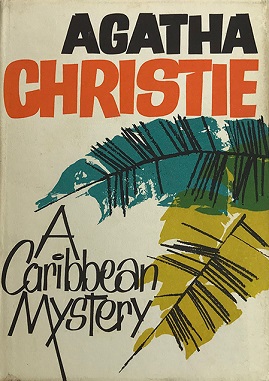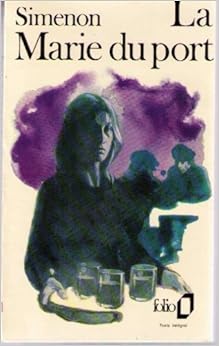I have already reviewed the six short stories that I am going to talk about here in my review of the short story collection called
THE THIRTEEN PROBLEMS.
But when I read those I hadn't really understood that the first 6 stories in the collection were the first appearance of Miss Marple, and that when they were published in the USA some of them were re-titled to reflect their connection to "The Solving Six".
These six stories were all published 1927-1928 whereas Jane Marple's first appearance in a novel was in MURDER IN THE VICARAGE in 1930. The stories have recently been individually republished as e-books by Harper Collins, and it is these that I have read most recently.
 |
Illustration by Gilbert Wilkinson of Miss Marple
(December 1927 issue of The Royal Magazine) |
A group of friends are meeting at the house of Miss Marple in St Mary Mead. As well as the old lady herself, there is her nephew - the writer Raymond West - the artist Joyce Lemprière, Sir Henry Clithering (a former Scotland Yard commissioner), a clergyman called Dr. Pender, and Mr Petherick, a solicitor.
The conversation turns to unsolved mysteries; Raymond, Joyce, Pender, and Petherick all claim that their professions are ideal for solving crimes. Joyce suggests that they form a club; every Tuesday night, a member of the group must tell of a real mystery, and the others will attempt to solve it. Sir Henry agrees to participate, and Miss Marple brightly volunteers herself to round out the group.
At first only Sir Henry Clithering seems to have any intimation that Jane Marple might be the best sleuth amongst them.
The connecting thread of the 6 stories is laid out in
The Tuesday Night Club, first published in the UK in December 1927, and in the USA as
The Solving Six in 2 June 1928.
After the Tuesday Night Club is set up, the first story comes from
Sir Henry Clithering.
Sir Henry, until recently Commissioner of Scotland Yard,
tells a tale about tinned lobster that caused a fatal case of food
poisoning.
~~~~~~~~~~~~~~~~~~~~~~~~

The second story
The Idol House of Astarte was first published in the UK in January 1928 and in the USA as
The Solving Six and the Evil Hour in 9 June 1928.
The story, told by the clergyman
Dr Pender is a strange and tragic experience from his youth.
Years ago, a murder was committed on the night of a costume party thrown
by Sir Richard Haydon, a man who was a rival of his cousin Eliot for
the affections of the lovely Diana Ashley. Sir Richard’s estate
contained the grove of Astarte, which held a mysterious stone summer
house. The summer house was rumoured to have been the site of numerous
sacred rites in years long past, and in a surprise act, Diana enacted
the role of Astarte, startling Sir Richard who stumbled and fell. When
the others reached him body, he was found dead of a knife wound to the
heart. ~~~~~~~~~~~~~~~~~~~~
Ingots of Gold, first published in the UK in February 1928, and in the USA in 16 June 1928 as
The Solving Six and the Golden Grave, comes from Raymond West.
Raymond West approaches the Tuesday Night Club after his visit to John
Newman, a friend who is searching for the Spanish ship Otranto which was
shipwrecked off the coast of Cornwall. When John Newman disappears for
days, upon his return he claims that he had been abducted by the thieves
who had stripped the Otranto of its gold, and that the local pub
landlord had worked with them.
~~~~~~~~~~~~~~~~~~~
The Blood-Stained Pavement was first published in the UK in March 1928 and in the USA as
Drip! Drip! 23 June 1928.
I found it interesting that
The Solving Six has disappeared from the US title.
The story is told by
Joyce Lempriere. It is something that happened five years before and has haunted her ever since. She was vacationing at a small inn on the Cornish coast. She was
painting a picture of the front of the inn, including details of wet
bathing suits drying on the balcony of Denis and Margery Dacre, when she
realised she had included blood stains on the pavement. A few days
later Margery is found having drowned and the Club are called to solve
the mystery.
~~~~~~~~~~~~~~~~~~~~~~~~~~~
Motive v. Opportunity was first published in the UK in April 1928 and first appeared in the USA as
Where's the Catch? on 30 June 1928. Again
The Solving Six link is missing.
Attorney
Mr Petherick relates an incident involving the late Simon
Clode, a wealthy client. Obsessed by his granddaughter’s death, despite
the presence of his young niece and nephew, Clode turns to spiritualist
Eurydice Spragg to contact his granddaughter in the afterlife. Clode
then decided to write a new will, leaving Eurydice as the benefactor
excluding his family. To everyone’s surprise, when the envelope
containing the will is opened, the paper is blank.
~~~~~~~~~~~~~~~~~~~
The final story is Miss Marple's.
The Thumb Mark of St. Peter was first published in the UK in May 1928 and then in the USA as
The Thumb-Mark of St. Peter on 7 July 1928.
Fifteen years ago, Miss Marple’s niece, Mabel Denman was accused of
murdering her husband. Mabel’s marriage had been an unhappy one, as
Geoffrey had been abusive and violent. Can Miss Marple clear her niece’s
name and reveal the true perpetrator?
~~~~~~~~~~~~~~~~~
So here are 6 very early Miss Marple stories. You can pick them up individually from Amazon or Harper Collins for your e-reader or look for a copy of THE THIRTEEN PROBLEMS.
Well worth the hunt.
You might like to check The Thirteen Problems on
Wikipedia.
My rating: 4.5.






























